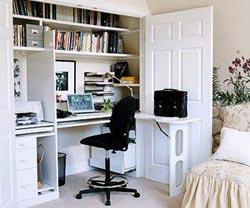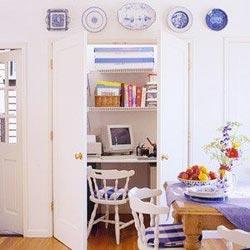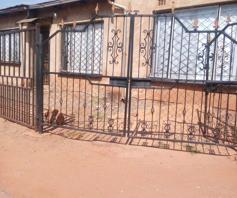In the past, when many houses were larger than those built today, the fortunate occupants had space to set aside as a study or a sewing room. Nowadays, with space at a premium, few people can spare a whole room in this way; however, it is possible to find an unused corner in a large living room, an uneven shaped space in a hall, or even part of a bedroom that can be turned into a work area with comparative ease, given some thought and ingenuity.

The essential aim is to establish a separate area, where all your equipment can be stored and used without having to clear it away when the area is wanted for some other purpose. After all, there is nothing more irritating than having to move dozens of pieces of paper and reference books from the dining room table just because it is time for dinner.
Location
Although surprisingly small areas can be adapted to make a workroom or study, there are limitations. For example, you must be able to stand up without banging your head and the worktop should measure at least 1,2m x 600mm to be sufficient for most purposes. Also, bear in mind that very small spaces can often overwhelm you with feelings of claustrophobia, making it impossible to work.

One way around such problems is to design a work surface that opens out to encroach on some other area while you are actually working, but which can be folded away when it is not being used. For example, the core home office might be inside something little more than a landing cupboard. While you are working, the work surface can be made to extend on to the landing itself, but when you have finished, all your equipment can slide out of sight behind doors. In this way, what was once a junk cupboard under the stairs can be transformed into a mini functioning home office, complete with a filing cabinet, bookshelf and desk.
Basic considerations
Whatever sort of work area you are planning, lighting is a major consideration. Ideally, your work surface should be in front of a window so that you get as much natural light as possible; however, you may not always be working in daylight and work areas tucked away in cupboards and corners may have no windows at all. Here, a central light will be required, as well as a desk lamp for more directed light.

A plug point will be necessary for the work area as electricity will be required to drive the desktop lighting, telephones, fax machines, computers, laptops, printers and possibly a heater in winter. It would be wise to get an electrician to install a permanent plug-point here, as long extension cables running along the floor can be extremely dangerous.
A home office or study
Desks are available in an immense range of styles and materials, from mahogany reproduction partner’s desks, to the relatively inexpensive office furniture made from veneer-coated chipboard. Within reason, it is suggested that you buy the largest possible that you can afford and that can fit into the available space. Alternatively, for awkward spaces, trestle legs and a wooden top are an ideal and cost effective solution.

Storage is a very important consideration and you invariably need more than you think. Shelves are space-saving and will store a variety of objects in a tidy and neat manner. Containers on castors are ideal for those work areas where everything needs to slide out of sight when not in use. These are available as sets of drawers, small cupboards, open-top baskets and even tubs.
A comfortable chair is essential – it should be high enough to allow easy reach across the worktop, but low enough for legs to fit comfortably underneath the desk. And if you intend writing for any length of time, a good supporting back is vital, and if the chair has arms, they should not restrict movement. Finally, a pinboard of some sort or a whiteboard is invaluable.
The colours you choose for your home office or study are, of course, a matter of personal taste. Remember, however, that highly patterned wallpapers can be distracting and large expanses of plain white may cause too much glare. Small areas are best decorated in neutral shades to create the illusion of a bigger space.
A sewing room
The main essential for a swing room is a large, sturdy worktop. Laminated chipboard is ideal because it can be kept scrupulously clean and there are no splinters to snag delicate fabrics. A cover trestle table is also an excellent choice, especially if it can be positioned to allow access from all sides.
The worktop needs to be fairly high as you will stand for most of the jobs carried out here, though you could keep a high stool handy. However, you will also need a lower table if you have a portable sewing machine, and a straight-back chair for working at the machine. If there is room, an upholstered chair is relaxing when you are sewing by hand.
Here too, containers on castors are excellent for storing small items and equipment, and stacks of wire trays permit an easy choice of cottons and threads. Widely spaced all shelves are suitable for storing fabrics and deep, narrow drawers are ideal for keeping paper patterns tidy. A folding ironing board is easily stored out of sight and can be brought out whenever it is required.
A kitchen desk
A desk in the kitchen need not be large and can be extremely helpful when you are writing shopping lists, referring to a cookery book or looking for a recipe online, paying your monthly bills or working on your monthly budget, when your kids need to surf the Internet for projects, or when they require your assistance with their homework and you need to cook. It needn’t be an elaborate space – but something small, contained and simple for optimum functionality. - Antonella Dési
Readers' Comments Have a comment about this article? Email us now.








